164 Search Results for visual schedule
January 31, 2022
by Carole Zangari -
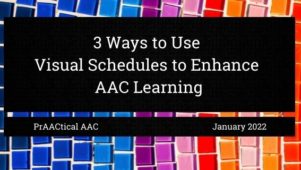
Visual schedules are a go-to strategy for helping AAC learners understand the plan for therapy or instructional session or a whole day. They have great utility beyond that, though. If you’re looking for ways to increase your use of this evidence-based strategy, here are some ideas to consider. Create a Visual Representation of an Activity: A powerful way to build understanding of and cooperation with an activity is to show what will be happening. This is particularly helpful when doing an activity that has a logical sequence or set of steps to be followed, such as making a smoothie or building a Lego car. We can create and teach the use of mini schedules depicting each element of the process to help our AAC clients/students become more comfortable and independent with the process. Parts of a Problem-solving Process: When AAC learners confront challenging situations, particularly those with a social or... [Read More...]
March 11, 2019
by Carole Zangari -
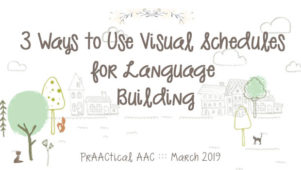
Visual schedules are powerful tools for supporting comprehension, reducing anxiety, and helping learners with AAC needs become more independent. They can also be used to build receptive and expressive language. To do that, though, the use of daily or mini/task schedules has to be part of an interactive experience, not an independent activity. If you’re willing to use schedules for language building, here are some ideas to consider incorporating. Sentence Building: This is an easy one. If you are working with an AAC learner who communicates primarily with one word/symbol at a time, slow down and take time to model short sentences every time you check the schedule together by adding a verb (e.g., GO to LifeSkills; EAT lunch, PUT AWAY your backpack). Once you’ve established that routine, you can pause to elicit those same sorts of sentences from the AAC learner. Verb Tense: As you use the schedule... [Read More...]
September 16, 2015
by Carole Zangari -
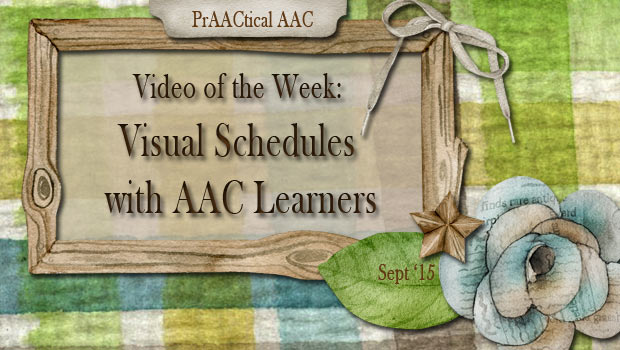
While our therapy sessions are highly individualized to meet the needs of specific individuals, there are a couple of strategies that are effective with almost every learner on our caseloads. Topping that list is the use of visual schedules. Whether it is a written agenda, a picture schedule for the session, a mini schedule for the parts of an activity, or an object schedule for the day’s events, this is one of the few strategies that has something to offer every learner. We’ve written before about this topic. In this post, you can find links to many of the topics we’ve addressed about making and using them. Today, we’ll look at a few videos on the use of this strategy. To get us started, here’s a video of Ann Syrstad sharing information about using this evidence-based intervention for individuals with ASD. Next, we head to Malaysia, where the Early Autism... [Read More...]
January 16, 2014
by Robin Parker -
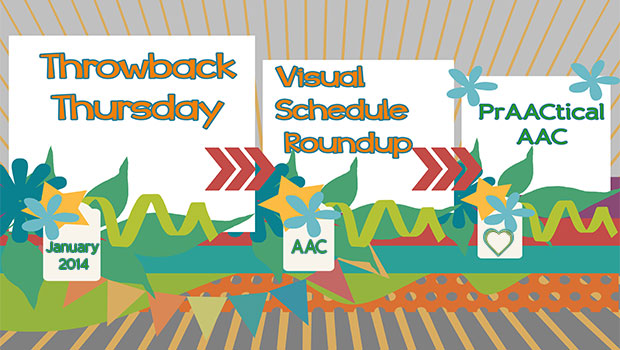
As times goes on in the academic year, we often think that everyone knows their schedules. But remember, knowing and seeing are two completely different things. For this Throwback Thursday, we wanted to go over visual schedules of all types to remind ourselves not to back off with schedules (all types) even if it seems everyone is transitioning well and knows their schedules. We wouldn’t want anyone to take away our day planner…. even when we knew our schedule. What’s the Connection- Core Words & Schedules Visual Schedules 411 Get Organized for the New Year: 5 Visual Schedule Apps Schedule Changes A Myth About Visual Schedules A PrAACtical Myth Lives On.. Again Visual Schedule Myths Live On and On… Power of the Visual Planner Schedules and Choices Riddle Me This AAC at Home: Visual Schedules and Supports Building Complex Schedules Ideas for Teaching the Use of Schedules PrAACtical Mini-Schedules Video... [Read More...]
January 3, 2014
by Robin Parker -

It’s a New Year- 2014. Most of us use schedules– even when we know and accept the schedule. Many of us use schedules even though we do not have ‘transition issues’. However, ‘seeing’ our schedules often helps decrease anxiety and assure us the day will be ok because even if there are some ‘not so great’ activities, most of what we do is fairly good. Schedules can be created by using materials ranging from no-tech to high-tech. You can teach talking about past, present, and future events with schedules. You can also use schedules to teach core words. Here are 6 great visual schedule apps to help with ‘teching’ up the process. By ‘teching up’ the process, we also can add to independence so ALL learners can create their own schedules. We think it is important to let you know that ALL of the app developers provide information about... [Read More...]
July 22, 2013
by Robin Parker -
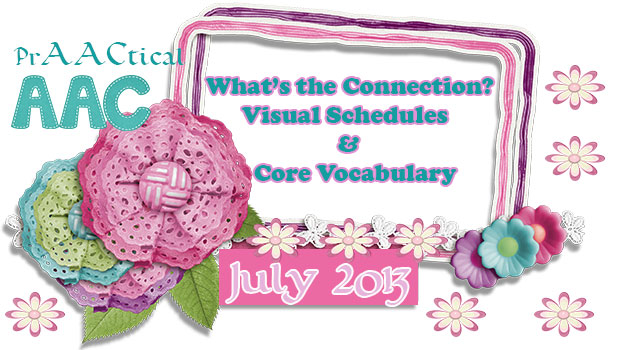
Because it seems there has been a lot of emphasis on core words and visual schedules over the past couple of months, we wanted to highlight a particular resource titled: Visual Schedules to Expose & Reinforce Core Vocabulary by (the great) Gail Van Tatenhove. This resource can be found on the Minspeak website which shares excellent (& free) comprehensive AAC information for everyone. You can search by categories and get fact sheets, communication boards, curriculum supports and more. AAC users, families, & caregivers Teachers and therapists Academicians & students Teaching Plans & Materials Pixon Project Resources Try out some of the ideas from the Visual Schedule/Core Word Resource or something else and let us know what you think.
July 11, 2013
by Robin Parker -
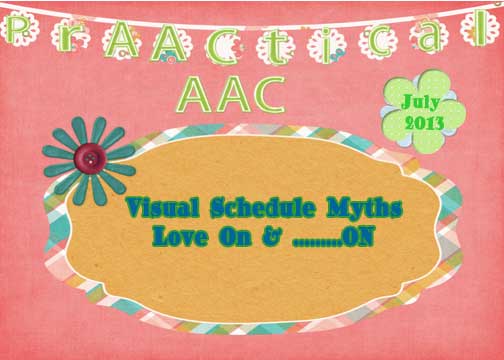
There are many myths about visual schedules for learners with special needs. Those myths multiply for older learners as well as for learners who are thought to have higher or lower skills. It is amusing to us (in a not really funny way) that these myths don’t typically extend to the SLP’s, educators, or other professionals and THEIR schedules/day planners. We have heard a lot of visual schedule myths in the last couple of weeks, which means the topic may need some re-visiting. Here are some TRUTHS about visual schedules. Please share if these myths come up in your area. Visual Schedules Increase INDEPENDENCE– Independence is supported when you can follow a visual schedule and do not need another person with you to tell you the steps to complete a day or a task. Independence is also facilitated when you can check for yourself when an event is happening rather than... [Read More...]
July 9, 2012
by Carole Zangari -
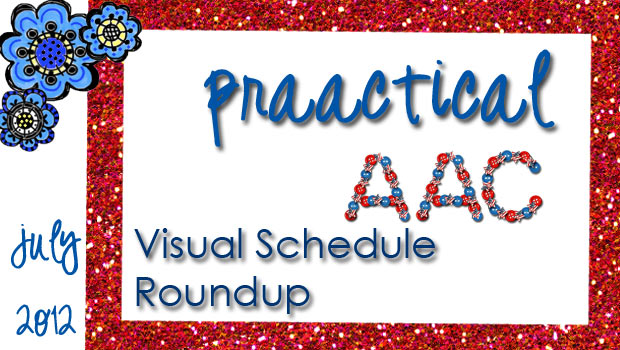
Summer is not the season we typically connect with routine, predictability, and structure. Nonetheless, if strategy really works to make someone’s life better, we try to use it whenever possible. Visual schedules work. They REALLY work. So whether you’re using them this summer or just preparing for the fall, we hope you enjoy this round-up of our past posts on Visual Schedules. – Riddle Me This (clinical rationale) Tech it Up’- 5 Visual Schedule Apps (tools) Visual Strategies 411 (implementation) PrAACtical Mini Schedules (implementation) Ideas for Teaching the Use of Visual Schedules (implementation) Object Schedules (video) Strategy of the Month: Types of Visual Schedules (implementation) Visual Schedules in Action (video) Building Complex Schedules (video) Schedule Changes (Video) AAC at Home: Visual Schedules and Supports Schedules and Choices (implementation) Visual Schedules & Inclusion (video) A Myth About Visual Schedule Lives On (implementation) Visual Schedule Wrap-Up (implementation + resource list) –
June 8, 2012
by Robin Parker -
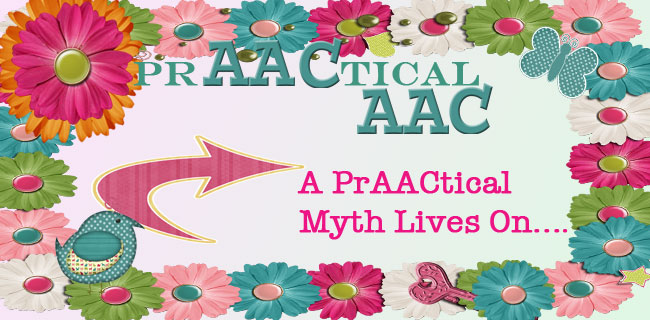
A myth about visual schedules continues to rear its ugly head in a prAACtical situation. Another family was instructed to discontinue a visual schedule because “the schedule will become a crutch, the schedule will result in dependence, and the schedule can not be used forever or all over town”. I need to start with an apology for not following up after my earlier post when I first realized that the visual schedule myth lived on. Maybe my punishment was hearing the same myth repeated (though it doesn’t seem fair that a student was impacted in the process). But maybe it was a teaching opportunity for me. It certainly made me respond quickly. So now for the down and dirty summary of my conversation with the other ‘professional’ . Having the conversation was my attempt at helping my student receive the visual language supports that she needed. I have to admit, it... [Read More...]
April 30, 2012
by Robin Parker -
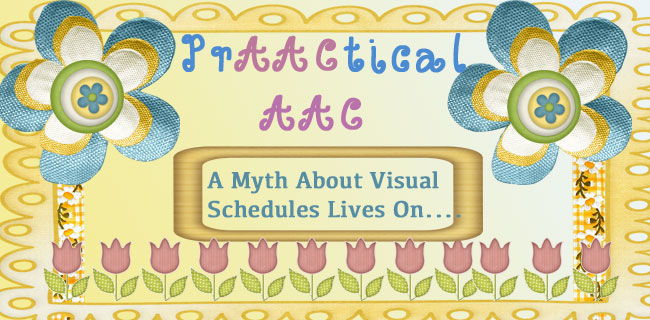
Nooooo, not again. A myth about visual schedules continues to rear its ugly head in a prAACtical situation (maybe we can reframe it into a learning opportunity??). Some history- A parent of twin girls with autism (age 15 and two other younger children– yes total 4) stopped by our office to pick up some autism awareness materials yesterday (a super busy mom in so many ways —going out of her way to help our community). As we were exchanging pleasantries and getting updates on how the girls were doing, we heard something that continues to surprise us–(and not in a good way). What did we hear? We heard that the girls were doing relatively well (not the surprising comment) but that mom was extra busy because the girls were no longer independent in taking their showers. They could do it by themselves but didn’t like the sensory input of soap... [Read More...]









